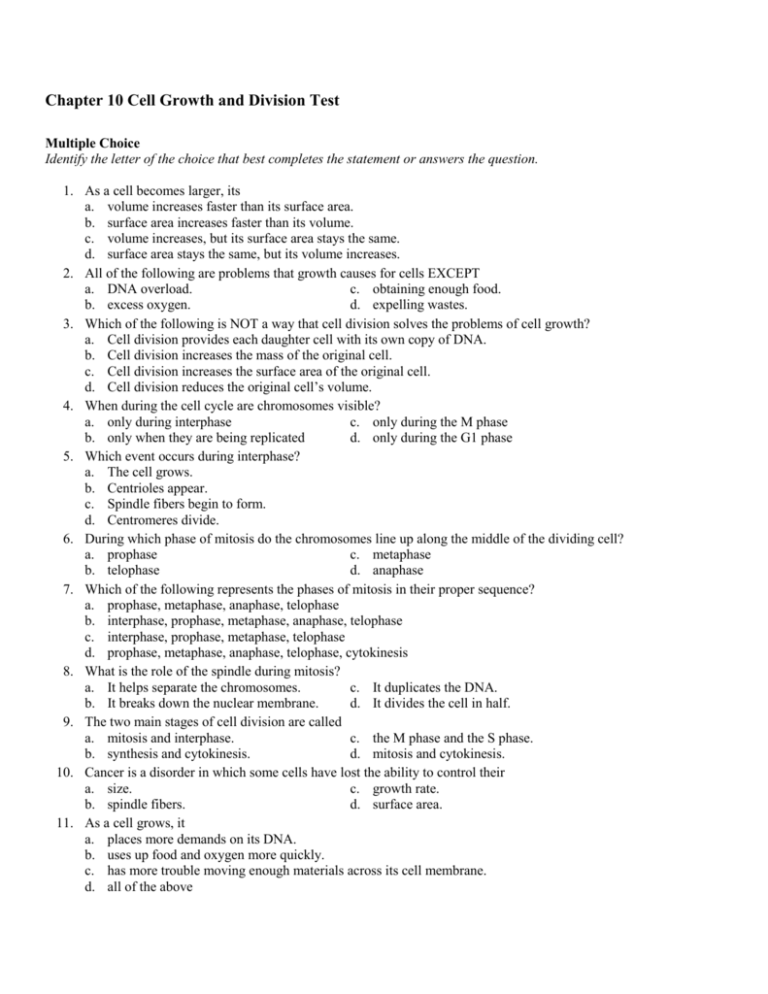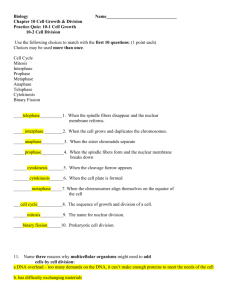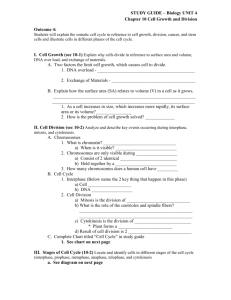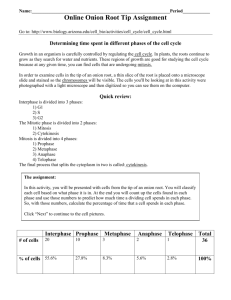Cell Growth & Division Test
advertisement

Chapter 10 Cell Growth and Division Test Multiple Choice Identify the letter of the choice that best completes the statement or answers the question. 1. As a cell becomes larger, its a. volume increases faster than its surface area. b. surface area increases faster than its volume. c. volume increases, but its surface area stays the same. d. surface area stays the same, but its volume increases. 2. All of the following are problems that growth causes for cells EXCEPT a. DNA overload. c. obtaining enough food. b. excess oxygen. d. expelling wastes. 3. Which of the following is NOT a way that cell division solves the problems of cell growth? a. Cell division provides each daughter cell with its own copy of DNA. b. Cell division increases the mass of the original cell. c. Cell division increases the surface area of the original cell. d. Cell division reduces the original cell’s volume. 4. When during the cell cycle are chromosomes visible? a. only during interphase c. only during the M phase b. only when they are being replicated d. only during the G1 phase 5. Which event occurs during interphase? a. The cell grows. b. Centrioles appear. c. Spindle fibers begin to form. d. Centromeres divide. 6. During which phase of mitosis do the chromosomes line up along the middle of the dividing cell? a. prophase c. metaphase b. telophase d. anaphase 7. Which of the following represents the phases of mitosis in their proper sequence? a. prophase, metaphase, anaphase, telophase b. interphase, prophase, metaphase, anaphase, telophase c. interphase, prophase, metaphase, telophase d. prophase, metaphase, anaphase, telophase, cytokinesis 8. What is the role of the spindle during mitosis? a. It helps separate the chromosomes. c. It duplicates the DNA. b. It breaks down the nuclear membrane. d. It divides the cell in half. 9. The two main stages of cell division are called a. mitosis and interphase. c. the M phase and the S phase. b. synthesis and cytokinesis. d. mitosis and cytokinesis. 10. Cancer is a disorder in which some cells have lost the ability to control their a. size. c. growth rate. b. spindle fibers. d. surface area. 11. As a cell grows, it a. places more demands on its DNA. b. uses up food and oxygen more quickly. c. has more trouble moving enough materials across its cell membrane. d. all of the above 12. Compared with small cells, large cells have more trouble a. dividing. b. producing daughter cells. c. moving needed materials in and waste products out. d. making copies of their DNA. 13. The process by which a cell divides into two daughter cells is called a. cell division. c. interphase. b. metaphase. d. mitosis. 14. The cell cycle is the a. series of events that cells go through as they grow and divide. b. period of time between the birth and the death of a cell. c. time from prophase until cytokinesis. d. time it takes for one cell to undergo mitosis. 15. Which of the following is a phase of mitosis? a. cytokinesis c. anaphase b. interphase d. S phase 16. The first phase of mitosis is called a. prophase. c. metaphase. b. anaphase. d. interphase. 17. In which phase of mitosis do chromosomes become visible? a. prophase c. metaphase b. interphase d. telophase 18. What happens when cells come into contact with other cells? a. They divide more quickly. c. They produce cyclins. b. They stop growing. d. They produce p53. 19. In eukaryotic cells, the timing of the cell cycle is regulated by a. the centrioles. c. the spindle. b. cyclins. d. all of the above Chapter 10 Cell Growth and Division Test Reference Section MULTIPLE CHOICE 1. 2. 3. 4. 5. 6. 7. 8. 9. 10. REF: REF: REF: REF: REF: REF: REF: REF: REF: REF: p. 242 p. 241, p. 243 p. 243 p. 244 p. 246 p. 248 p. 246 p. 247 p. 245 p. 252 11. 12. 13. 14. 15. 16. 17. 18. 19. REF: REF: REF: REF: REF: REF: REF: REF: REF: p. 241 p. 241 p. 243 p. 245 p. 246 p. 246 p. 246 p. 250 p. 251








